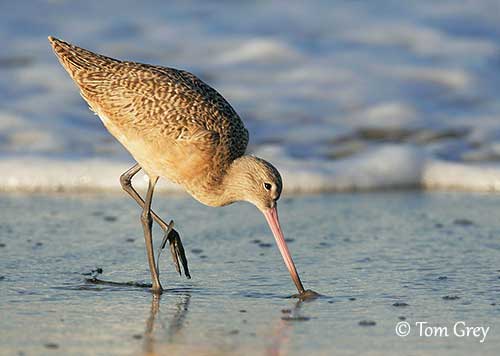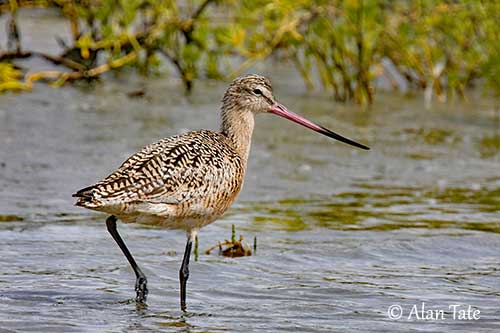
Fr: Barge marbrée
Ang: Marbled Godwit
All: Marmorschnepfe
Esp: Aguja Canela
Ita: Pittima marmorizzata
Nd: Marmergrutto
Sd: präriespov
Photographers:
Roger Ahlman
Pbase Galleries Peru and Ecuador & My bird pictures on IBC
Tom Grey
Tom Grey's Bird Pictures & Tom Grey's Bird Pictures 2
Alan & Ann Tate
AA Bird Photography
Ingo Waschkies
Bird Photography
Text by Nicole Bouglouan
Sources:
HANDBOOK OF THE BIRDS OF THE WORLD Vol 3 by Josep del Hoyo-Andrew Elliott-Jordi Sargatal - Lynx Edicions - ISBN : 8487334202
SHOREBIRDS by Peter Hayman, John Marchant and Tony Prater – Christopher Helm – 1986 – ISBN: 0747014035
GUIDE DES LIMICOLES de D. Taylor - Delachaux et Niestlé - ISBN : 2603014080
All About Birds (Cornell Lab of Ornithology)
The Birds of North America online
Bird Web (Seattle Audubon Society)
What Bird-The ultimate Bird Guide (Mitchell Waite)
Wikipedia, the free encyclopaedia
NORTHWEST WILDLIFE PRESERVATION SOCIETY
Marbled Godwit
Limosa fedoa
Charadriiformes Order – Scolopacidae Family
INTRODUCTION:
The Marbled Godwit is the largest of the four godwit species. It typically shows longs legs and bill, well-adapted to the foraging behaviour in marshes, beaches and mudflats. These birds nest on the ground in short grass.
This migratory bird has two subspecies, one of them breeds in Alaska Peninsula while the second one breeds in W Canada and NC Great Plains (USA). They migrate after breeding to spend the winter on the southern coasts of USA and Mexico, but they can reach South America too.
The Marbled Godwit has currently stable to slightly declining populations, but the species is not globally threatened.

DESCRIPTION OF THE BIRD:
Biometrics:
Length: 42-48 cm
Wingspan: 70-80 cm
Weight: M: 278-396 g – F: 312-510 g
The Marbled Godwit in breeding plumage has brownish-black and pale chestnut-buff spotting and barring on the upperparts, giving the bird a speckled appearance. Rump and uppertail are dark brown with dull buff/cinnamon spotting. The tail is barred cinnamon and brown.
On the upperwing, the coverts have brown centres and cinnamon edges. The primary coverts are dark brown. We can see a cinnamon wingbar.
The underparts are pale cinnamon, with thin brown barring on breast, whereas flanks and undertail are more obscurely barred. Both underwing-coverts and axillaries are bright cinnamon.
On the head, the crown is dark brown. Supercilium, chin and sides of the face are pale cinnamon-buff. We can see a conspicuous dark eyestripe across lores and upper ear-coverts.
The hindneck is cinnamon with dark brown streaks, while the foreneck is whitish-buff.
The long bill is upcurved and pointed, often bicoloured. The base is mostly pink with some variations, whereas the tip is blackish. The eyes are dark brown. Long legs and feet are grey to blue-grey.
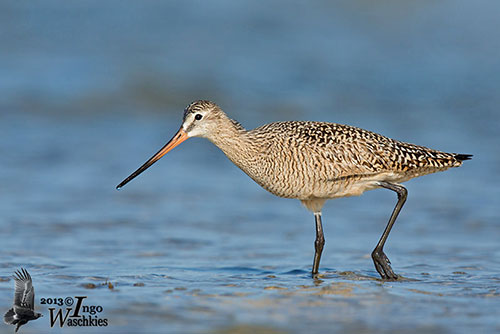
Male and female are fairly similar, but the female is slightly larger with more sparsely barred plumage.
The Marbled Godwit in non-breeding plumage is paler with more uniform plumage above. The underparts are paler with little brown barring.
The juvenile resembles non-breeding adult, but it has buff-fringed upperpart feathers and cinnamon-buff underparts with little streaking.
SUBSPECIES AND RANGE:
The Marbled Godwit has two subspecies.
L.f. beringiae breeds in Alaska Peninsula and winters on Pacific coasts of USA, from Washington to C California.
This race has shorter bill, wing and tarsus, and may appear heavier than nominate.
L.f. fedoa (described above) breeds in C Alberta, S Saskatchewan and S Manitoba, S in USA to SC Montana, N Dakota and W Minnesota, and also in SW James Bay.
It winters from California and the Carolinas S to Panama. Some records are occasional S to Venezuela and Colombia to Chile.
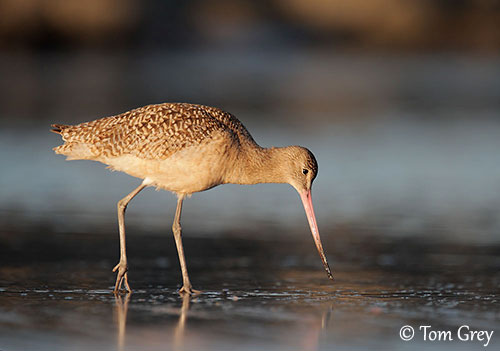
HABITAT:
The Marbled Godwit frequents prairies, mudflats, pools and shores, but during the breeding season, it is mostly found on N Great Plains in wet meadows with nearby ponds and marshes. Some populations are known nesting on tundra in the northernmost part of the breeding range.
During migration and winter, they can be seen mainly in coastal regions around tidal mudflats, marshes and ponds.
CALLS AND SONGS: SOUNDS BY XENO-CANTO
The Marbled Godwit gives a loud, harsh “cor-ack” used as contact call. During the displays, some “ger-whit” and a barking “rack-a” are usually repeated. When the bird is threatened, it utters a sharp “wik-wik”.
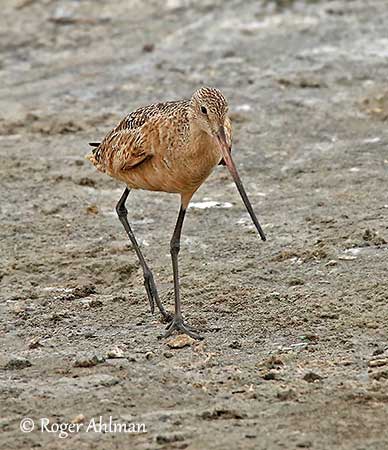
BEHAVIOUR IN THE WILD:
The Marbled Godwit feeds primarily on insects, mainly grasshoppers. But molluscs, crustaceans, roots and seeds of aquatic plants are also part of its diet.
It forages by probing in mud or water thanks to its long bill, and the head may sometimes disappear under water. The food items are found mainly by touch with the bill tip. Insects are also caught from the ground or the vegetation in prairies.
The Marbled Godwit is both diurnal and nocturnal feeder. At high tide, they form large flocks that roost together in meadows. In shallow water, numerous birds can be seen standing while probing in the mud.
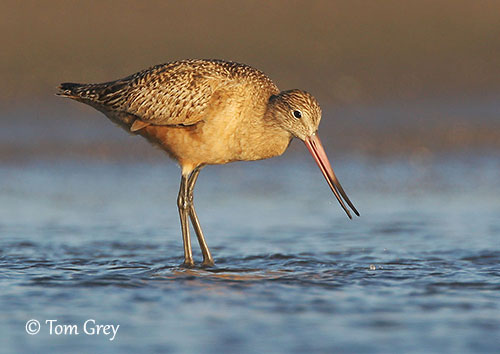
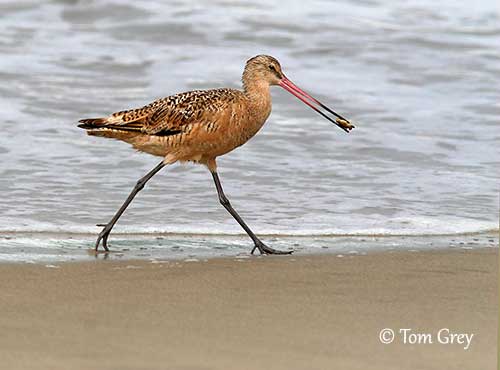
The Marbled Godwit is monogamous and usually nests in low densities throughout the range. They often nest in semi-colonial groups, but the territories are not clearly defined.
The male performs aerial displays over the breeding territory, a high circling flight ending in a steep dive. This flight is accompanied by loud calls. Both mates also perform ritual nest-scrape on the ground.
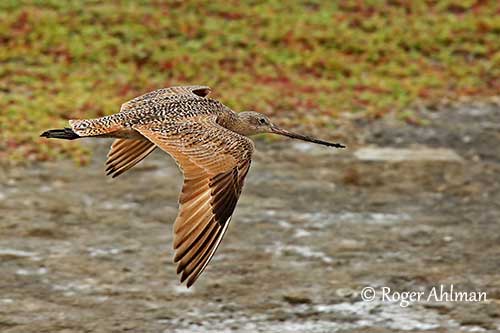
The Marbled Godwit is migratory and moves to southern coastal areas in winter. Most of them spend the winter N of Panama, but they may reach South America. They migrate in flocks and on relatively short distances.
The flight is strong and direct.
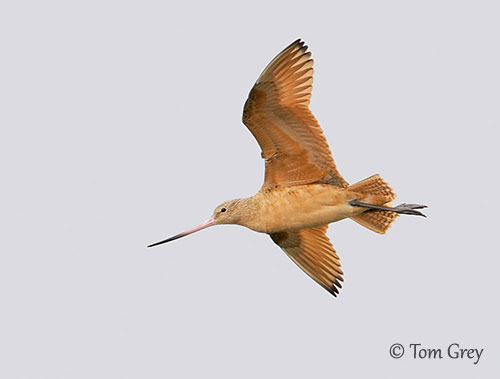
REPRODUCTION OF THIS SPECIES:
The laying occurs from early May to June in North Dakota, but later further North.
The Marbled Godwit often nests in semi-colonial groups, with up to 27 pairs/km². It nests in wet meadows and grassy areas, usually near pools.
The nest is on the ground, a shallow depression lined with grass and placed in short grass on dry spot. There is sometimes a kind of canopy made with grass arranged above the nest.
The female lays 4 pale buff/olive eggs with darker spots. Both adults incubate during 21-23 days (the male often at night). The incubating adult remains motionless even when it is closely approached.
The downy chicks are buffy-brown with dark markings on head and upperparts, and pinkish-buff below. Both parents rear the chicks that fledge 26-30 days after hatching. However, the chicks leave the nest very soon after hatching, and are able to feed themselves, accompanied by their parents.
The eggs are vulnerable to predation by mammals and other birds.
PROTECTION / THREATS / STATUS:
The Marbled Godwit has currently stable population, but some declines appeared in the 1800s and until late 20th century, due to hunting. Following some recovery, the population is now declining again due to the loss of nesting habitats converted to farmland.
But the Marbled Godwit is not globally threatened and currently evaluated as Least Concern.
